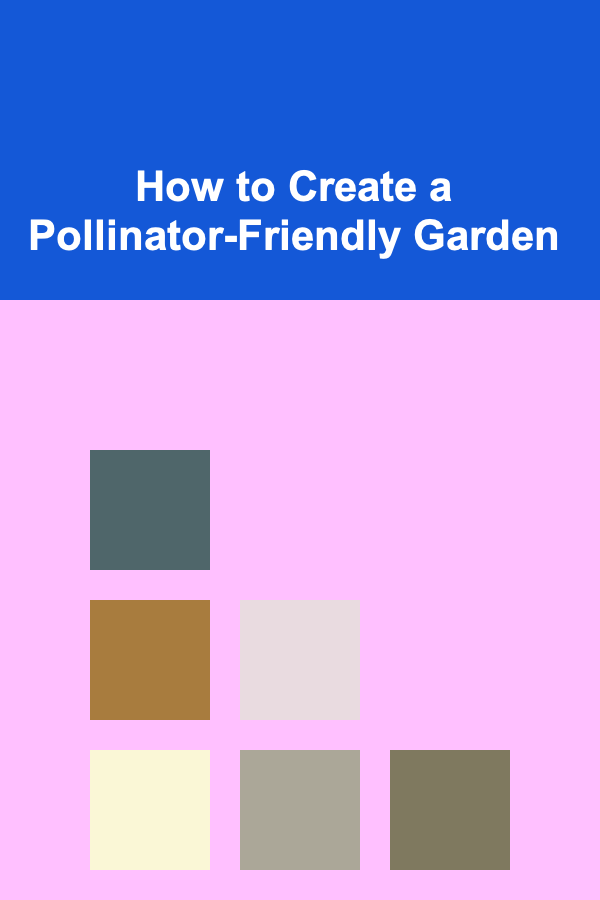
How to Create a Pollinator-Friendly Garden
ebook include PDF & Audio bundle (Micro Guide)
$12.99$5.99
Limited Time Offer! Order within the next:

Pollinators play a vital role in the health of ecosystems, ensuring the reproduction of plants by transferring pollen from one flower to another. The importance of pollinators in agriculture and biodiversity cannot be overstated. As their numbers decline due to habitat loss, pesticide use, and climate change, it's crucial to create environments that support these essential creatures. One of the best ways to support pollinators is by cultivating a pollinator-friendly garden.
A pollinator-friendly garden is not only beneficial for bees, butterflies, birds, and other pollinators, but it also contributes to a more biodiverse and resilient ecosystem. This guide will explore how you can design and maintain a garden that attracts and supports pollinators, helping to reverse the troubling trends of pollinator decline.
Understanding Pollinators and Their Importance
What Are Pollinators?
Pollinators are animals that assist in the transfer of pollen between flowers, leading to fertilization and the production of fruits and seeds. These creatures include:
- Bees: The most efficient and well-known pollinators. They include honeybees, bumblebees, and solitary bees.
- Butterflies and Moths: Their delicate wings and long proboscises allow them to feed on nectar and move pollen.
- Birds: Hummingbirds, in particular, are excellent pollinators due to their long, specialized beaks.
- Bats: In some regions, bats are important pollinators of nocturnal flowers.
- Other insects: Flies, beetles, and wasps also contribute to pollination, albeit in less specific ways than bees.
Why Pollinators Are Important
Pollinators are responsible for the reproduction of 75% of flowering plants and approximately 35% of the world's food crops. They pollinate plants that provide us with fruits, vegetables, nuts, and seeds, contributing to food security and the health of ecosystems.
In addition to their role in agriculture, pollinators are crucial for maintaining the biodiversity of natural habitats. Many wild plants depend on pollinators for their survival, and without them, entire ecosystems could collapse. Pollinators are also essential for the production of seeds and fruits that feed wildlife, further emphasizing their ecological significance.
Steps to Create a Pollinator-Friendly Garden
Creating a garden that attracts and supports pollinators involves more than simply planting flowers. A well-designed pollinator garden requires careful thought about the types of plants, the structure of the garden, and its maintenance. Below are the key steps to creating a pollinator-friendly garden:
1. Choose Native Plants
The foundation of any pollinator garden is its plant life. Native plants are the best option for supporting pollinators because they have evolved alongside these creatures, providing the right nectar, pollen, and habitat for local species. Native plants are also more resilient to local pests and diseases, making them easier to care for than non-native species.
Why Native Plants?
- Better Adaptation: Native plants are better adapted to the local climate, soil, and weather conditions, requiring less water, fertilizer, and pesticide use.
- Attracting Local Pollinators: Native pollinators, like bees and butterflies, have evolved to recognize and thrive on local plants. Non-native species may not offer the same ecological benefits.
- Supporting Biodiversity: Native plants support local ecosystems by providing food and shelter to native wildlife, including pollinators.
How to Choose Native Plants
Research your region's native plants to find those that are most beneficial for local pollinators. Look for plants that bloom at different times of the year to ensure a continuous supply of nectar. Additionally, choose plants that attract a variety of pollinators, such as bees, butterflies, hummingbirds, and moths.
For example:
- Early Spring: Crocus, hellebores, and willows.
- Summer: Milkweed, sunflowers, bee balm, and purple coneflower.
- Fall: Asters, goldenrod, and sedums.
2. Provide a Diversity of Flower Shapes and Sizes
Different pollinators are attracted to different types of flowers. To support a wide range of pollinators, including bees, butterflies, and hummingbirds, plant a diversity of flowers with varying shapes, sizes, and colors. For example, long-tubed flowers like trumpet vines or foxglove are ideal for hummingbirds, while flatter flowers like daisies are favored by bees.
Flower Types for Different Pollinators:
- Bees: Bees are attracted to flowers with flat, open shapes, which allow them to easily land and collect nectar. Bees also prefer flowers that are blue, purple, or yellow.
- Butterflies: Butterflies tend to prefer flowers with flat, clustered petals like butterfly bush, coneflower, and lantana.
- Hummingbirds: Hummingbirds are drawn to tubular flowers in red, orange, or pink, as they can easily access nectar with their long beaks.
- Moths: Moths tend to prefer pale or white flowers that bloom at night and have a strong fragrance.
3. Provide Nesting Sites and Shelter
Pollinators need more than just food -- they also require suitable habitats for nesting and shelter. Including a variety of nesting sites and shelters will help ensure that pollinators remain in your garden throughout the seasons.
Nesting Sites for Bees:
- Solitary Bees: These bees do not live in colonies like honeybees but instead nest in small burrows in the ground or in hollow stems. To create suitable nesting sites, leave some areas of bare ground or plant stems with hollow centers, like bamboo or elderberry.
- Honeybees: While honeybees typically live in hives managed by beekeepers, you can still support them by planting plenty of nectar-rich flowers and providing a water source.
Shelter for Pollinators:
- Trees and Shrubs: Many pollinators, including bees and butterflies, use trees and shrubs for shelter. Planting trees that provide both food and shelter can attract pollinators and offer protection from the elements.
- Rock Piles and Logs: Rocks and logs provide shelter for ground-dwelling insects and a place for pollinators to rest and find protection from predators.
4. Avoid Pesticides and Herbicides
Pesticides and herbicides are harmful to pollinators and can kill them directly or indirectly by contaminating the plants they feed on. To create a pollinator-friendly garden, avoid using chemicals that can harm these vital creatures.
Alternative Pest Control Methods:
- Integrated Pest Management (IPM): This method uses a combination of natural predators, traps, and organic sprays to control pests without harming pollinators.
- Beneficial Insects: Encourage beneficial insects like ladybugs and lacewings, which naturally control pests in your garden.
- Handpicking: For smaller pest problems, try handpicking insects off your plants rather than using chemicals.
5. Create a Water Source
Pollinators also need water to drink, especially during hot summer months. A simple birdbath, a shallow dish, or a small pond can provide a safe and reliable water source for pollinators. Make sure to keep the water shallow and add stones or twigs to give pollinators a place to land without the risk of drowning.
6. Provide Seasonal Interest
Pollinators need food sources throughout the year. By planting a variety of flowers that bloom in different seasons, you ensure that your garden provides a continuous supply of nectar and pollen. This is particularly important in early spring and late fall when food sources may be scarce.
Seasonal Planting Tips:
- Spring: Plant early-blooming bulbs, such as crocuses, daffodils, and hyacinths.
- Summer: Ensure your garden has a steady supply of mid-season flowers like lavender, bee balm, and sunflowers.
- Fall: Include late-blooming plants like asters, goldenrod, and sedum.
7. Educate Others and Involve the Community
Creating a pollinator-friendly garden can have a ripple effect, inspiring others to do the same. Educate your friends, neighbors, and community about the importance of pollinators and share tips for creating gardens that support them. You could even start a community garden project or a pollinator-friendly initiative in your area to help create a larger network of habitats for pollinators.
Conclusion
Creating a pollinator-friendly garden is a rewarding and impactful way to support the health of our ecosystems and the planet. By planting native species, providing a variety of flowers, offering shelter and nesting sites, and avoiding harmful pesticides, you can create a thriving environment for pollinators. The benefits of such a garden extend beyond pollination, contributing to biodiversity, food security, and a more sustainable environment for future generations.
As individuals, we have the power to make a positive difference in the world by creating spaces that foster the life of pollinators. Through conscious gardening practices, we can help ensure the survival of these vital creatures, supporting the beauty and richness of the natural world.

How to Declutter Your Home Before Moving
Read More
How to Prepare Healthy Breakfast Options for the Week
Read More
How to Sell Personalized Pet Portraits on Etsy: A Comprehensive Guide
Read More
How to Set Up a Checklist for Regular Website Security Audits
Read More
How to Stage a Living Room to Appeal to Potential Buyers
Read More
How To Launch Your Own Bakery from Home: A Comprehensive Guide
Read MoreOther Products

How to Declutter Your Home Before Moving
Read More
How to Prepare Healthy Breakfast Options for the Week
Read More
How to Sell Personalized Pet Portraits on Etsy: A Comprehensive Guide
Read More
How to Set Up a Checklist for Regular Website Security Audits
Read More
How to Stage a Living Room to Appeal to Potential Buyers
Read More